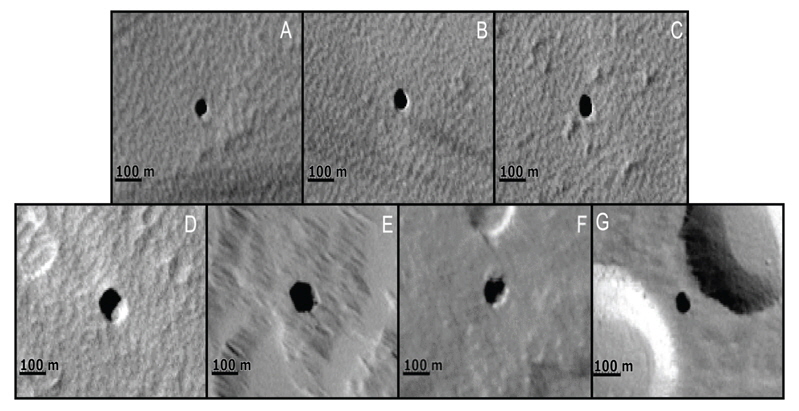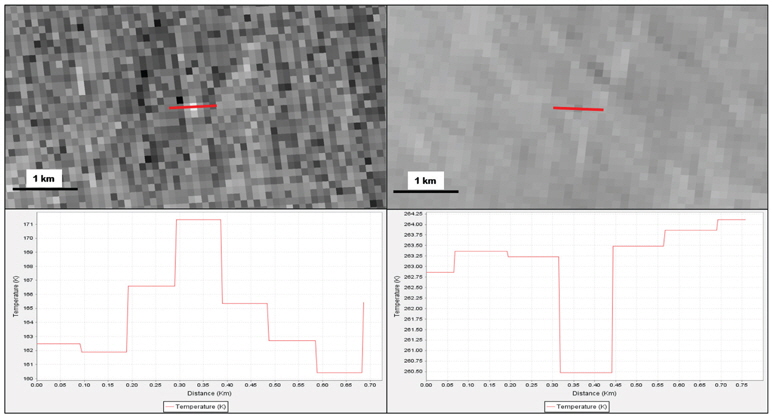



Recently, the candidate sites of caves have been discovered on the Moon and the planet Mars. Lunar and Martian caves have attracted much attention as possible habitats for the human. The cave had been used as a shelter protecting residents from external hazards since the primitive Earth. Hörz (1985), Coombs & Hawke (1992), and De Angelis et al. (2002) have studied lava tubes as a habitat shielding from meteorite impacts and radiations on lunar surfaces. In the study of the cave on Mars, Cushing et al. (2007) have discovered the six cave candidates around Arisa Mons in Tharsis Montes using Thermal Emission Imaging System (THEMIS) on Mars Odyssey. Cave candidates were found based on the temperature changes at daytime and nighttime using the Thermal Emission Imaging System (THEMIS) for the sites of potential cave candidates. Cushing (2010) has discovered many cave candidates in the northwest of Arsia Mons. In the study of the cave on the Moon, Haruyama et al. (2009) have discovered cave candidates in Marius hills region of the Moon. Also, Haruyama et al. (2010) have discovered cave candidates in Mare Tranquillitatis and Mare Ingenii on the Moon. Robinson et al. (2012) have also discovered cave candidates of more than 150 in many lunar craters using the images of Narrow Angle Camera (NAC) on Lunar Reconnaissance Orbiter (LRO). Wynne et al. (2009) showed a difference in a day and night temperature change between a cave entrance and a non-cave on Earth.
In this paper, we have found the cave candidates on Mars. Also, the cave candidates were studied using the method of Cushing et al. (2007) around volcanic regions in Tharsis Montes.
All data were collected from CTX and THEMIS. The Context Camera (CTX) is an optical instrument on Mars Reconnaissance Orbiter (MRO) with the resolution of 6 meter per pixel. Also, CTX provides grayscale images in the wavelength range of 500nm to 800nm. Thermal Emission Imaging System (THEMIS) is an instrument on board the Mars Odyssey. THEMIS has five wavelength visual imaging system and nine wavelength infrared imaging system. Also, THEMIS provides multi-spectral infrared images at the resolution of 100 meter per pixel and provides visible images with the resolution of 18 meter per pixel (Christensen et al. 2004).
We have used the CTX data to search for the cave candidates by visual examination. And then, we have checked the temperature changes at daytime (15:00~18:00) and nighttime (02:00~05:00) local time on Mars using THEMIS for the cave candidates. This method is similar to that of Cushing et al. (2007).
All the cave candidates were sought and analyzed using Java Mission-planning and Analysis for Remote Sensing (JMARS). JMARS was developed by Arizona State University's Mars Space Flight Facility. Also, it provides mission planning and data-analysis tool to NASA’s orbiter (Christensen et al. 2009). The temperature change during daytime and nighttime was received by JMARS, too.
Cave candidates have been sought over large volcanic region such as Olympus Mons, Arsia Mons, Pavonis Mons, and Ascraeus Mons.
Using CTX’s data on MRO, we have found seven cave candidates. This candidates were named arbitrarily as A through G (Fig. 1). The information of seven cave candidates is listed in Table 1.
As indicated in Table 1, the cave candidates have been found on Pavonis Mons and Ascraeus Mons in Tharsis Montes. We have examined the temperature changes at daytime and nighttime for seven cave candidates.
[Table 1.] Information on the proposed sites of caves.

Information on the proposed sites of caves.
According to the study of temperature change using the THEMIS instrument for the seven cave candidates, Candidate E (249.21°E, 0.33°N) shows distinct temperature changes at daytime and nighttime (Fig. 2).
In Fig. 2, the left image shows a dark hole clearly in the center. The middle image shows daytime temperatures using THEMIS at 14:45 around the cave candidate. The image shows that the temperature is kept almost constant around the area. The right image shows nighttime temperatures at 04:08 over the same region. The nighttime image shows that the cave candidate is brighter than other area indicating that the temperature of the cave candidate is higher.
Fig. 3 shows temperature changes at nighttime (04:08) and daytime (14:45) of Candidate E. The left graph shows temperature changes in the nighttime (04:08). And the right graph displays temperature changes in the daytime (14:45). X-axis indicates distance (km) and y-axis indicates temperature (K). And x-axis covers 3 pixels each to left and right of the cave candidate. According to the temperature change in the graph, the cave candidate E is located between 0.3 km and 0.4 km in the nighttime and between 0.3 and 0.45 km in the daytime, respectively. The visual sizes of the cave candidates look different on the graphs because of the resolution limit of THEMIS IR. The maximum temperature shown in the graph is 264K in the daytime and the temperature of cave candidate E is around 260.5K. On the contrary, the minimum temperature of the graph is 160~161K while the temperature of the cave candidate is 171K. This results suggests that the cave candidate E has a better possibility of a cave compared to other candidates. Fergason et al. (2006) have shown that the RSS (Root Sum Total) total is 2.8K in nighttime temperature using THEMIS at 180K in NEΔT. Where NEΔT is a noise equivalent delta temperature.
In this paper, we have found the seven cave candidates on Ascraeus Mons and Pavonis Mons in Tharsis Montes on Mars using Context Camera (CTX) data on Mars Reconnaissance Orbiter (MRO). And the information of cave candidates (Fig. 1; Table 1) were verified. Given the fact that the interior temperature of the cave is kept constant during daytime and nighttime (Wynne et al. 2009), we have searched cave candidates using Thermal Emission Imaging System (THEMIS) on Mars Odyssey (Cushing et al. 2007) and analyzed the temperature changes at daytime and nighttime for the seven cave candidates found. The results of the temperature analysis show that the temperature of Candidate E (249.21°E, 0.33°N) is kept constant during daytime and nighttime. In Fig. 3, the nighttime temperature of Candidate E shows that the temperature of dark hole is 10 degrees higher than the other areas. This fact suggests that the cave candidate E has a better possibility to be a cave compared to other candidates.
However, we cannot verify a cave based on the visible image data and the temperature change of the area only. Thus, we must find other ways to confirm the cave candidates and to enhance the reliability for candidate E as a cave entrance. Also, it is difficult to distinguish the temperature change of smaller caves less than 100 meters because THEMIS IR has a resolution of 100 meters per pixel. So we need a new equipment to have the better resolution than 100 meters per pixel.
Finding caves on Mars, a totally new phase of research could be started. The cave would be an essential outpost for the future human race to conduct a scientific research work on Mars.



